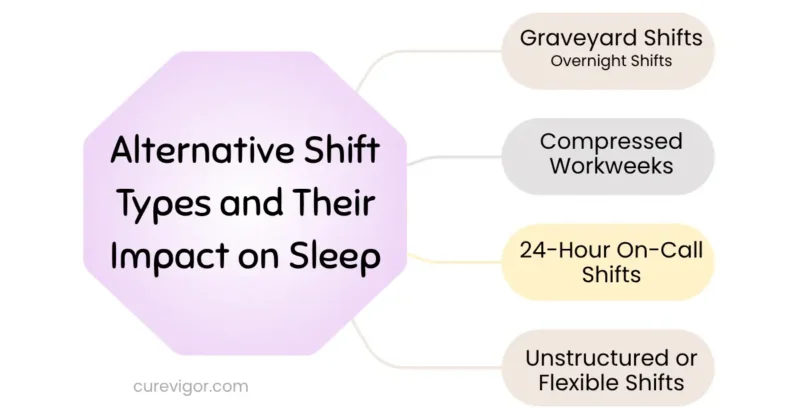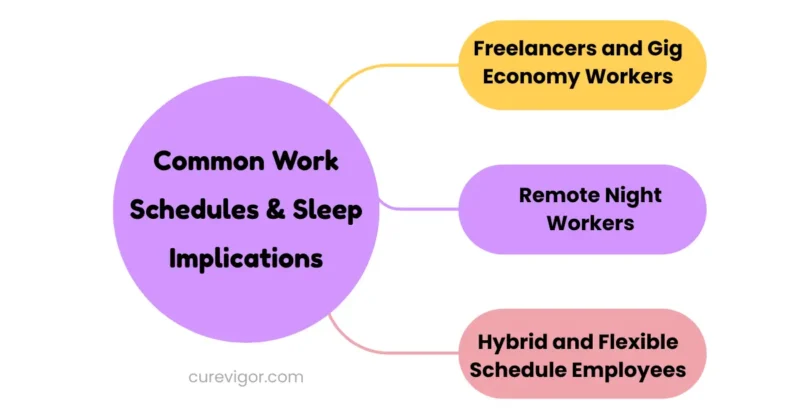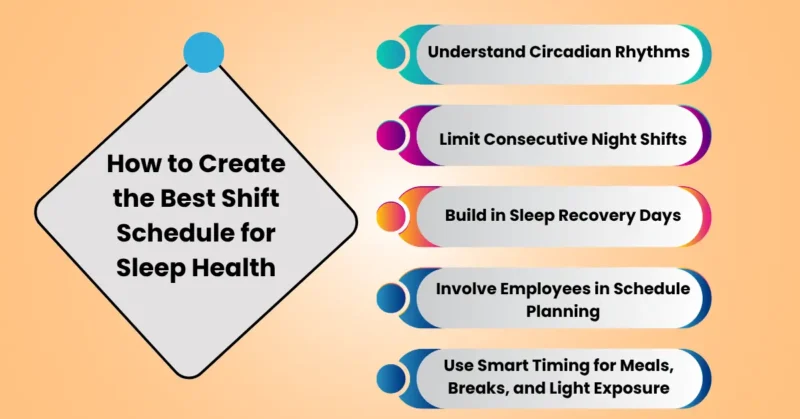Struggling to sleep during night shifts? Discover the best proven sleep schedule, expert tips, and real-world templates to help you rest better and feel energized.
Thank you for reading this post, don't forget to subscribe!Getting quality sleep while working night shifts isn’t just difficult — it’s a science. If you’re constantly tired, wired, or wide awake when you need to rest, you’re not alone. The good news? With expert-backed strategies, shift-specific schedules, and a little planning, you can finally train your body to rest when the world is awake. Let’s break down the best proven sleep schedule for night shift workers — and how to make it work for your lifestyle.
1. Understanding Work Shift Types

When it comes to creating a healthy sleep schedule, the first step is understanding your shift type. Not all work shifts are created equal, and some can disrupt your sleep far more than others. Here’s a breakdown of the most common shift types, how they affect your internal clock, and why they matter for your rest and recovery.
Fixed Shifts (Day, Evening, or Night)
Fixed shifts mean you work the same hours every day, whether it’s a standard 9-to-5 or an 11 PM to 7 AM overnight shift.
- Pros: Your body can gradually adapt to a consistent routine.
- Cons: Night shifts can still fight your natural circadian rhythm, especially if you’re exposed to daytime light after work.
- Best Sleep Strategy: Stick to the same sleep-wake time, even on weekends.
Rotating Shifts (Forward or Backward)
Rotating shifts change frequently — you might work mornings this week and nights next week.
- Forward rotation (day → evening → night) is easier on your body than backward (night → evening → day).
- Cons: Your circadian rhythm is repeatedly disrupted, leading to increased sleep debt and fatigue.
- Best Sleep Strategy: Gradually shift your sleep time by 1–2 hours before each new rotation.
Split Shifts
Split shifts break your workday into two parts, like 6 AM to 10 AM and 4 PM to 8 PM.
- Cons: Fragmented schedules leave little room for deep, restorative sleep.
- Best Sleep Strategy: Try to get one long nap (at least 90 minutes) and another shorter one to mimic a whole night’s rest.
On-Call Shifts
You may be called in unexpectedly — common in healthcare and emergency services.
- Cons: High unpredictability, which can lead to sleep fragmentation and increased stress.
- Best Sleep Strategy: Use controlled naps and wind-down rituals when off-duty.
Why Knowing Your Shift Type Matters
Your shift type determines the extent of control you have over your sleep-wake cycle. Fixed shifts (especially day shifts) give you the most flexibility, while rotating or irregular shifts demand stricter sleep hygiene and environmental control.
In the next section, we’ll explore alternative shift types that fall outside the norm — and why they can be just as challenging for your sleep.
2. Alternative Shift Types and Their Impact on Sleep

Beyond standard fixed and rotating schedules, many workers follow alternative shift patterns that can make maintaining healthy sleep even more challenging. These schedules are prevalent in high-demand or flexible industries and can significantly disrupt your circadian rhythm if not managed carefully.
Graveyard Shifts (Overnight Shifts)
Often running between 10 PM and 6 AM, graveyard shifts require you to stay alert while your body naturally wants to sleep.
- Common in healthcare, logistics, and security sectors.
- Long-term exposure to graveyard shifts is associated with sleep disorders, low melatonin production, and even increased health risks like obesity or diabetes.
- Sleep Tip: Use blackout curtains, reduce blue light exposure after work, and maintain consistent wake-up times even on days off.
Compressed Workweeks
Compressed schedules allow full-time hours over fewer days (e.g., four 10-hour days instead of five 8-hour days).
- These can be attractive for achieving a work-life balance, but may require workers to start early mornings or work late evenings.
- Impact on Sleep: Long shifts can delay bedtime, shorten sleep duration, or disrupt recovery time.
- Sleep Tip: Protect your off days as sleep recovery days. Avoid drastically altering your sleep schedule for social reasons.
24-Hour On-Call or Extended Duty Shifts
Some workers, such as first responders or utility technicians, remain on-call for 24-hour periods or longer.
- Sleep is often broken into short segments or skipped altogether during emergencies.
- Impact on Sleep: Interrupted sleep reduces REM and deep sleep, increasing the risk of burnout and cognitive errors.
- Sleep Tip: Prioritize rest immediately after the shift and take strategic naps before your on-call window.
Flexible or Unstructured Shifts
Freelancers, gig workers, or remote professionals may have no fixed shift at all.
- While flexibility can be beneficial, it often leads to irregular sleep patterns and difficulty winding down.
- Impact on Sleep: Inconsistent bedtimes disrupt the sleep-wake cycle, leading to insomnia or daytime drowsiness.
- Sleep Tip: Set artificial boundaries — such as a “digital shutdown hour” — to simulate a consistent routine.
Why These Shift Types Demand Special Sleep Strategies
Workers on alternative shifts face more unpredictable and irregular sleep opportunities, making proactive planning essential. Without structured recovery time, these schedules can contribute to chronic sleep debt, reduced mental focus, and long-term health issues.
In the next section, we’ll explore other modern work schedules, including those in the gig economy and hybrid remote jobs, and how these are influencing sleep behaviors in today’s workforce.
3. Other Common Work Schedules and Sleep Implications

Not all workers follow traditional shift patterns. With the rise of remote work, freelance gigs, and digital nomadism, many people now operate on unconventional or self-set schedules. While these offer flexibility, they can also create serious sleep challenges without proper structure.
Freelancers and Gig Economy Workers
Freelancers and gig workers—such as delivery drivers, ride-share operators, and online service providers—often have the flexibility to choose their hours.
- While this flexibility allows for personal freedom, it often leads to inconsistent bedtimes, late-night screen exposure, and irregular wake times.
- Impact on Sleep: A lack of routine can confuse your internal clock, making it more difficult to fall asleep and stay asleep.
- Best Practice: Use scheduling tools to block specific work hours and enforce a consistent sleep window, even if it shifts slightly from day to day.
Remote Night Workers
Many remote jobs now operate across global time zones. Customer service reps, IT staff, and virtual assistants may work nights to support clients abroad.
- Working in isolation and staring at screens at night can lower melatonin levels, leading to increased sleep disruption.
- Impact on Sleep: The brain remains stimulated after engaging in screen-heavy, high-focus tasks, which delays the natural onset of sleep.
- Best Practice: Use blue-light filters, create a strict “shutdown” routine, and end work at least an hour before bedtime.
Hybrid and Flexible Schedule Employees
As more companies adopt hybrid work models, employees may work from home part-time or have flexible login hours.
- Without fixed boundaries between work and rest, some people overwork or stay mentally “on” late into the night.
- Impact on Sleep: Inconsistent end-of-day routines and unstructured breaks reduce sleep quality and quantity.
- Best Practice: Maintain a consistent sleep-wake rhythm and avoid shifting sleep by more than 60 minutes between weekdays and weekends.
Why Modern Flexibility Still Requires Structure
Even when you’re in control of your hours, sleep isn’t just about when you want to rest — it’s about when your body needs to rest. Disrupting your natural rhythm too often can increase the risk of insomnia, fatigue, and mood disorders.
The key is to treat sleep with the same priority as your work. In the next section, we’ll break down real-world examples of shift patterns by industry and how those workers can adapt their sleep plans to protect health and performance.
4. Real-World Examples of Shift Patterns by Industry
Understanding how different industries operate can help night-shift workers and employers design more realistic, health-conscious sleep routines. Below are real examples of shift structures used across major sectors—and how they affect sleep health.
Healthcare
Typical Shift Pattern: 12-hour shifts (7 AM–7 PM or 7 PM–7 AM), often on rotating schedules.
- Challenge: Night shifts in hospitals involve high cognitive demand and patient interaction, which can delay the wind-down of sleep even after the shift ends.
- Sleep Impact: Irregular rotation disrupts circadian rhythm and increases the risk of chronic sleep loss.
- Adaptation Tip: Use blackout curtains and prioritize daytime sleep to help you get a better night’s sleep. Advocate for forward-rotating schedules.
Transportation and Logistics
Typical Shift Pattern: Early morning (e.g., 3 AM–11 AM) or overnight driving shifts.
- Challenge: Driving during natural sleep hours increases the risk of fatigue. Irregular delivery routes can worsen inconsistency.
- Sleep Impact: High rates of sleep apnea and microsleeps are reported in long-haul drivers.
- Adaptation Tip: Short naps before shifts and avoiding heavy meals during overnight routes can help maintain alertness.
Emergency Services (Police, Firefighters, EMS)
Typical Shift Pattern: 24-hour on-call shifts or 10–12-hour night rotations.
- Challenge: Sleep is frequently interrupted by emergency calls and adrenaline spikes.
- Sleep Impact: Reduced deep sleep, especially during on-duty rest breaks.
- Adaptation Tip: Plan recovery sleep blocks immediately after your shift to ensure optimal rest. Maintain a regular sleep routine on off days.
Hospitality and Food Service
Typical Shift Pattern: Evening to late-night shifts (5 PM–1 AM or later), especially on weekends.
- Challenge: Social hours overlap with work time, limiting social rest and recovery.
- Sleep Impact: Workers may delay sleep to socialize, further reducing their rest.
- Adaptation Tip: Establish strict sleep boundaries after late shifts, including a wind-down routine and controlling the use of light.
Manufacturing and Industrial Work
Typical Shift Pattern: Rotating or fixed night shifts, often 10 PM–6 AM or similar.
- Challenge: Physically demanding tasks combined with overnight schedules result in high fatigue levels.
- Sleep Impact: Risk of accidents and poor sleep quality from early morning exposure to daylight.
- Adaptation Tip: Wear blue-light-blocking glasses when commuting home, and avoid stimulating activities before bed.
Key Insight: Every Industry Has Its Sleep Challenges
While shift timing varies across industries, the need for a stable, well-managed sleep plan is universal. Whether you’re saving lives, stocking shelves, or delivering packages, adjusting your sleep schedule to fit your role is crucial for maintaining long-term health and optimal performance.
Next, we’ll explore the benefits and drawbacks of different shift types—and how some patterns may support better sleep than others.
5. Benefits and Drawbacks of Different Shift Types

Not all shift schedules have the same impact on your body. Some offer more flexibility for rest, while others can seriously interfere with your biological clock. Understanding the pros and cons of each shift type can help you or your team make more intelligent decisions about sleep planning, productivity, and long-term well-being.
Fixed Shifts
Overview: Same schedule daily, day, evening, or night.
Benefits:
- It is easier to establish a consistent sleep routine.
- The body adapts to predictable sleep-wake times.
- Suitable for long-term planning and work-life balance.
Drawbacks:
- Night shifts still misalign with the natural circadian rhythm.
- Social life and daytime activities can be limited.
Sleep Insight: Fixed night shifts allow adaptation over time, especially when paired with controlled light exposure and blackout environments.
Rotating Shifts
Overview: Work hours change periodically (e.g., days to nights every few days or weeks).
Benefits:
- Allows broader workforce coverage.
- Increases exposure to various teams and tasks.
- It may feel less monotonous to some employees.
Drawbacks:
- Disrupts circadian rhythm repeatedly.
- Increases risk of insomnia, fatigue, and chronic sleep debt.
- It is more challenging to plan meals and family time or maintain consistent routines.
Sleep Insight: Forward-rotating shifts (day → evening → night) are less harmful than backward-rotating patterns. Gradual changes with built-in transition time reduce sleep loss.
Split Shifts
Overview: Two or more work periods within a 24-hour day (e.g., morning + evening).
Benefits:
- A break between shifts allows for flexibility to run errands or rest.
- It may work well in industries with peak-hour demand (like transportation or hospitality).
Drawbacks:
- Sleep often becomes fragmented.
- It is more challenging to achieve a complete cycle of deep, restorative sleep.
Sleep Insight: Two naps per day — one longer (90+ minutes) and one shorter (20–30 minutes) — can help compensate for disrupted nighttime sleep.
Compressed Workweeks
Overview: Full-time hours condensed into fewer days (e.g., four 10-hour shifts).
Benefits:
- More consecutive off days for rest or personal time.
- Reduced commute and greater scheduling freedom.
Drawbacks:
- Long shifts can delay bedtime and increase fatigue.
- Sleep debt may accumulate by the end of the workweek.
Sleep Insight: Use off-days to recover sleep, but avoid drastic changes in sleep timing to maintain circadian stability.
On-Call and Emergency Shifts
Overview: Workers are available to respond at any time during a set period, often overnight.
Benefits:
- Flexibility between callouts.
- Opportunity for rest between emergency tasks.
Drawbacks:
- Sleep is frequently interrupted.
- High stress and unpredictability worsen sleep quality.
Sleep Insight: Focus on sleep recovery after on-call periods. Even short, uninterrupted naps can restore alertness during shift windows.
Choosing the Least Disruptive Schedule
While there’s no one-size-fits-all solution, permanent night shifts with consistent routines often outperform rotating or split shifts in terms of sleep health, provided they are paired with strict light and sleep hygiene practices. For employers, offering stability and control over shift assignments can significantly boost worker well-being and productivity.
In the next section, we’ll dive into how to create the best shift schedule, balancing operational needs with employee health.
6. How to Create the Best Shift Schedule for Sleep Health

Designing a shift schedule isn’t just about covering business hours — it’s about protecting your team’s physical and mental well-being. Poorly structured shifts can lead to burnout, sleep disorders, and higher turnover. Fortunately, you can design shift schedules that are both operationally efficient and sleep-friendly by using science-backed principles.
Understand Circadian Rhythms
The body’s internal clock is designed to promote alertness during daylight and sleep at night. Disrupting this rhythm repeatedly — especially with rotating or late-night shifts — can lead to chronic fatigue, poor focus, and long-term health problems.
Best Practice:
- Prioritize day shifts when possible.
- If night shifts are necessary, keep them consistent.
- Schedule forward-rotating shifts (day → evening → night) rather than backward.
Limit Consecutive Night Shifts
While some employees may prefer block scheduling (e.g., four consecutive night shifts), fatigue builds up quickly. Studies suggest that more than three consecutive night shifts significantly increase the risk of cognitive errors and poor sleep.
Best Practice:
- Cap night shifts at 2–3 in a row.
- Include at least 48 hours of rest afterward.
- Avoid quick turnarounds (e.g., working the night shift followed by an early morning shift) to minimize fatigue.
Build in Sleep Recovery Days
Sleep debt doesn’t just “go away” after a single night of rest. Long or irregular shifts require intentional recovery time built into the weekly schedule.
Best Practice:
- Add recovery days after intense rotations.
- Avoid expecting full productivity after night or split shifts.
- Encourage rest on days off, not constant availability.
Involve Employees in Schedule Planning
Employee input matters — especially when it comes to health. When workers help shape their schedule, they’re more likely to follow sleep-friendly routines.
Best Practice:
- Allow shift swaps or self-scheduling when possible.
- Use surveys or feedback tools to assess fatigue and sleep quality.
- Provide sleep hygiene resources (e.g., guides and workshops).
Use Smart Timing for Meals, Breaks, and Light Exposure
Optimizing shift timing isn’t only about work hours — meal and light exposure play a critical role in sleep regulation.
Best Practice:
- Schedule bright-light exposure early in night shifts.
- Limit caffeine and large meals after 3–4 AM.
- Encourage workers to wear blue-light-blocking glasses during post-shift commutes.
Summary of Shift Scheduling Strategies
| Principle | Why It Works |
|---|---|
| Fixed or Forward Rotation | Supports circadian alignment |
| Limit to 2–3 Night Shifts | Reduces cumulative fatigue |
| Build Recovery Days | Prevents long-term sleep debt |
| Empower Employee Input | Improves compliance and satisfaction |
| Align Breaks with Sleep Science | Enhances overall energy and rest |
A thoughtful shift schedule is a powerful tool — not only for boosting performance but also for protecting the long-term health of your workforce. In the next section, we’ll provide a ready-to-use work schedule and sleep planner template that you can customize to your needs.
7. Work Schedules for Employees (Template)
A well-structured shift schedule template helps employees manage not only work hours but also sleep, meals, light exposure, and rest and recovery. This section provides a ready-to-use framework inspired by expert advice (like Dr. Charmane Eastman’s night-shift strategy) that supports better health and performance for night-shift workers.
Customizable Weekly Shift & Sleep Schedule
| Time | Activity | Notes |
|---|---|---|
| 11:00 PM | Begin Work | Use bright light or light therapy to simulate daytime. |
| 3:00 AM | Last Cup of Coffee | Avoid caffeine after this to protect sleep quality. |
| 3:30–4:00 AM | Main Meal (Dinner Equivalent) | Keep the room cool, silent, and dark. |
| 7:00 AM | End Shift & Commute | Wear sunglasses (preferably blue-light blockers). |
| 8:00 AM | Go to Bed | Blackout curtains + white noise for best rest. |
| 8:00 AM–3:00 PM | Sleep | Keep room cool, silent, and dark. |
| 3:30 PM | Wake Up & Breakfast | Step outside for 15+ minutes of sunlight if possible. |
| 4:00–8:00 PM | Exercise, chores, family time | Avoid caffeine or intense screens near bedtime. |
| 9:00 PM | “Lunch” (2nd main meal) | Keep consistent even on rest days. |
| 10:00–10:45 PM | Wind-Down Routine | Keep it light and easy to digest. |
Weekly Overview Snapshot
| Day | Shift Type | Sleep Time | Key Notes |
|---|---|---|---|
| Monday | Night (11 PM–7 AM) | 8 AM–3 PM | Schedule a short nap if needed |
| Tuesday | Night | 8 AM–3 PM | Repeat routine |
| Wednesday | Night | 8 AM–3 PM | Schedule short nap if needed |
| Thursday | Off | 3 AM–Noon (Sleep) | Gradual shift to daytime schedule |
| Friday | Day Off | 3 AM–Noon | Try to limit sunlight until late AM |
| Saturday | Evening Shift | 4 AM–11 AM (Sleep) | Adjust gradually |
| Sunday | Night | 8 AM–3 PM | Resume night-shift routine |
Sleep Planning Tips (For Template Use)
- Set alarms for both bedtime and wake time to stay consistent.
- Use digital planners or Trello to track the effectiveness of the routine.
- Add notes about energy levels, mood, or fatigue to identify patterns.
- Adjust gradually — don’t make significant sleep shifts within 24 hours.
FAQs on the Best Proven Sleep Schedule
Q. What is the best sleep pattern for the night shift?
The optimal sleep pattern for night shift workers involves sleeping immediately after your shift, ideally between 8:00 AM and 3:00 PM. It helps align your rest period with your natural dip in alertness and body temperature. Maintain a dark, quiet, and calm environment in your room to enhance the quality and depth of your sleep. Use blackout curtains and a white noise machine, and limit screen time before bed.
Stick to a consistent daily schedule, even on days off, to stabilize your circadian rhythm. If needed, a short nap before your next shift can boost alertness. Light exposure at the right time (and darkness after work) also plays a key role.
Q. How long should night shift workers sleep?
Night shift workers should aim for 7 to 9 hours of uninterrupted sleep per day, just as day workers do. However, daytime sleep is naturally lighter and more fragmented, so sleep quality matters as much as quantity. To protect your sleep, avoid caffeine after 3 AM and wear blue-light-blocking glasses on your way home.
Creating a “sleep sanctuary” with blackout curtains, a fan, and a digital detox before bed helps ensure deeper rest. If uninterrupted sleep isn’t possible, two split blocks (e.g., 5 hours + 2 hours) can still be effective. Consistency is key to adjusting your body clock. Avoid drastically changing your sleep schedule on off days.
Q. Is the night shift good for your sleep?
Night shift is not ideal for your natural sleep cycle because it works against your circadian rhythm. Our bodies are naturally programmed to be awake during daylight and asleep at night, so reversing this pattern can lead to sleep disturbances, fatigue, and long-term health issues. However, you can minimize the impact by creating a stable routine and using sleep hygiene techniques.
Permanent night shifts are often less disruptive than rotating shifts. With careful planning and environmental control, night-shift workers can still get quality rest. But long-term exposure to night work should be balanced with regular health check-ups and recovery time.
Q. What is a good sleep schedule for a night?
A good sleep schedule for night shift workers begins with going to bed as soon as possible after your shift ends — ideally by 8:00 AM — and sleeping until 3:00 PM. It allows your body to enter deep sleep before core body temperature rises in the afternoon. Avoid sunlight exposure after work, and eat your last large meal before leaving the workplace to avoid digestive discomfort.
On your days off, try to maintain a similar sleep window or adjust slowly rather than flipping to a day schedule instantly. Stick to a pre-bedtime routine and minimize interruptions from noise and light. Over time, your body can adapt to this reversed cycle.
Building a Better Night Shift Sleep Schedule Starts with Science and Consistency
Working nights doesn’t mean sacrificing your health or sleep, but it does require thoughtful planning and strict routines. As we’ve explored, different industries follow a wide variety of shift types, and each comes with unique sleep challenges. From fixed and rotating shifts to on-call and compressed schedules, understanding your work pattern is the first step toward protecting your rest.
Creating the best sleep schedule for night shift workers means sleeping immediately after your shift, ideally between 8 AM and 3 PM, in a controlled, dark, and quiet environment. Using light therapy during your shift and avoiding caffeine after 3 AM can help your body stay alert at night and wind down in the morning. Sticking to a consistent wake-sleep rhythm, even on days off, is crucial for maintaining long-term sleep quality.
Aim for 7 to 9 hours of sleep, and don’t underestimate the power of short naps or recovery days when complete rest isn’t possible. While night shifts inherently disrupt the body’s natural rhythms, utilizing intelligent scheduling, environmental control, and employee input can help mitigate fatigue and enhance overall well-being.
Night shift sleep isn’t just possible — it’s manageable with the right tools, mindset, and structure. Download and personalize the free Sleep Schedule Template, test what works best for your lifestyle, and give your body the rest it deserves — even when the world is still asleep.
Read more Health and Wellness articles.
You might like:

